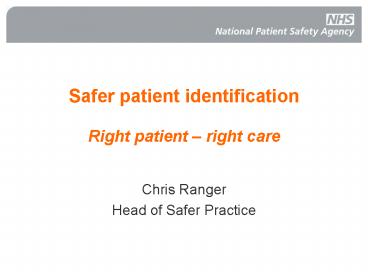Safer patient identification Right patient right care - PowerPoint PPT Presentation
1 / 13
Title:
Safer patient identification Right patient right care
Description:
10% of inpatient episodes in the UK result in error ... Blood transfusion safety - Delivery of a national standard specification for IT ... – PowerPoint PPT presentation
Number of Views:194
Avg rating:3.0/5.0
Title: Safer patient identification Right patient right care
1
Safer patient identificationRight patient
right care
- Chris Ranger
- Head of Safer Practice
2
What is the impact of errors in healthcare?
- Each year
- 10 of inpatient episodes in the UK result in
error - 850,000 of the 8 million hospital admissions in
England result in error - 2 billion is spent in England on extra days in
hospital - A significant proportion are patient
identification errors
3
Patient Safety a global issue
4
What goes wrong in matching patients with care?
- Patient is given the wrong treatment because
samples, specimens or x-rays arent matched with
the right patient - Patient is wrongly identified and gets treatment
intended for another patient - Patient is given the wrong treatment because of
failures in communication or checking
5
(No Transcript)
6
What has the NPSA done about mismatching?
- Commissioned two studies - one on manual checking
and one on matching with technologies - Right patient - right care summary document and
framework for action published 9th December 04 - Full reports of commissioned work available on
our website www.npsa.nhs.uk
7
What are the findings on manual checking and
mismatching?
- Bedside checking is a major source of errors in
matching patients with care - There is a high rate of missing patient
wristbands - Manual checking processes are not being formally
risk assessed
8
What are the findings on technologies and
mismatching?
- No single technology meets all the requirements
- Barcoding is currently the best technology for
avoiding mismatching but RFID is potentially a
more powerful tool - A mix of technologies may be best - different
mixes for different areas of care
9
Are technologies sufficient on their own?
- People use technology - it must be usable,
efficient and hard to override - Technology should confirm/validate manual checks
-NHS staff are still responsible for checking - How technology is implemented is as important as
the technology itself
10
What about Connecting for Health (NPfIT) and
Informing Healthcare?
- NPSA is working with CfH to ensure that any
technological solutions to mismatching are
consistent with the programme both nationally and
locally - Nationally Safety Officer seconded from the
NPSA - Locally working with Local Service Providers on
safety solutions - In regular contact with Informing Healthcare,
Wales
11
What next? - general
- NPSA will help the NHS, healthcare industry and
patients work together to devise and introduce
systems to help prevent mismatching - NPSA is monitoring advances in initiatives and
solutions to prevent mismatching details to
rightpatient_rightcare_at_npsa.nhs.uk
12
What next? Blood safety
- Blood transfusion safety - Delivery of a national
standard specification for IT tracking systems
endorsed by CfH - Recommendations to the NHS based on testing and
development of other potential solutions such as
photo-ID and better staff training
13
What next? Patient ID
- NPSA programme on Safer Patient ID
- Patient Safety Alert on wristband wearing in
acute settingsSept/Oct 05 - Standardising wristband design across the NHS
- Information standard (ISB) on patient identifiers
14
Safer patient identification
- Opportunity for questions
- Email enquiries to chris.ranger_at_npsa.nhs.uk































